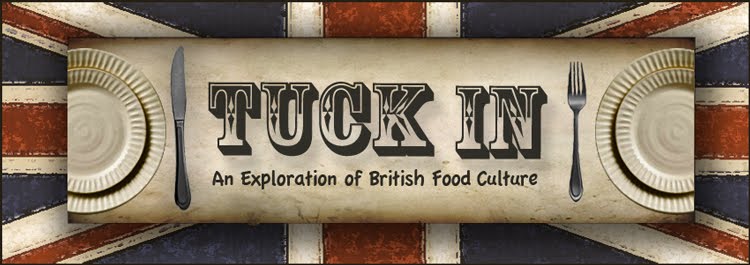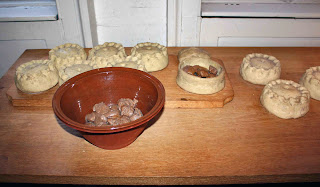 Every single time I pass by a restaurant’s sign on the street that advertises their fresh homemade pies, a little song always happens to creep into my head. And before I know it, for the fifth time that day I’m humming the tune of Sweeney Todd’s “There, you'll sample Mrs. Lovett’s meat pies, savory and sweet pies!….” Shall I go on? No, I didn’t think so. So you can only imagine the number of times I see Johnny Depp’s image in my head, not that I’m complaining or anything.
Every single time I pass by a restaurant’s sign on the street that advertises their fresh homemade pies, a little song always happens to creep into my head. And before I know it, for the fifth time that day I’m humming the tune of Sweeney Todd’s “There, you'll sample Mrs. Lovett’s meat pies, savory and sweet pies!….” Shall I go on? No, I didn’t think so. So you can only imagine the number of times I see Johnny Depp’s image in my head, not that I’m complaining or anything. Pies really are a staple of the English diet, but if you have images of goopy cherries in sugary crust in your head, then erase them immediately. If you want a pie in England, you are going to get a meat pie, a lovely little portable cylinder of savory pastry, stuffed with any sort of meat and sometimes vegetables, cheese, gravy and other delicious things. And the varieties are nearly endless. Some of the most popular choices are steak and kidney pie (and yes this really refers to actual kidneys), steak and ale, pork pie, chicken or lamb pies, and vegetarian pies usually filled with a sweet potato puree or something similar. Generally they are eaten with a nice dollop of mashed potatoes, mushy peas, and a ladleful of hot gravy but they are fine on their own too, eaten cold or warmed in the oven to make the pastry extra flaky.
And if you perhaps want a slightly lighter option, there is shepherd's pie which skips the pastry altogether and instead, ground beef and vegetables are topped with mashed potatoes and baked until hot. And to put everyone at ease, I have yet to find any pies similar to those in a Sweeney Todd production, so you’ll be pleased to know that I haven’t pulled any fingers or toes from my pies. And sweet pies do exist here but are not nearly as popular as they are in the states. You’ll see apple pie (actually and English invention) but most pastry desserts are more in the form of tarts, not pies.
So in my pie experiences thus far, there are two really worth mentioning, both of which I purchased from Borough Market. The first was admittedly a bit of risk, not only for my taste buds but for my teeth as well. I purchased a Mrs. King's game pie, stuffed with an interesting combination of pigeon, venison, rabbit and pheasant, and it came equipped with a warning that the pie may contain fragments of lead shot…great. And when it comes to pies, Mrs. King’s does it the right way. The crust is made from pure lard and flour and the meat filling is topped with a traditional jelly made from boiling pigs trotters. So one evening, when I had nothing else in the house, I heated up the game pie. The first bite was done quite tentatively, but after a few nibbles, I must admit it wasn’t to bad. The crust was amazingly flaky, I guess from the lard, and the inside had a good flavor, although slightly dry and gristley. I did eat most of it, but I do remember standing in my kitchen a few hours later saying, “I feel a little sick, although that could be because I just ate pigeon…” which sent my flatmates into fits of laughter and responding with “I believe that's the only time I’ll ever hear someone say that in my life.”
The second notable pie was a bit more modern though and generally people friendly. The brand was Pieminister, a company that constructs the pies in Bristol from all-natural ingredients. There are about twenty types, all with cutesy names and good flavor combinations that opt for butter crusts and gravy rather then the slightly terrifying lard and jelly. I went for the Mr. Porky Pie, filled with pork, bacon, apples, leeks, sage, and gravy. When I heated it in the oven, it turned a nice golden color and let off a lovely buttery aroma. The crust was also really crispy and flaky, although a bit lighter than the other pie, and the filling was so flavorful and moist. Paired with a nice side salad, it was a perfect English dinner.
And a little side note of pie history. They’ve actually been around for quite a while, like medieval times, but the concept was a bit different. Instead, The crust was not actually intended to be eaten but just used as a cooking vessel. Since ceramic cookware was costly and in limitation and some cookware could emit toxins when heated, this was the safest way of cooking. This also accounts for the little pot-like shape of pies. So the people made the bottom bowl part of the pie from the crust dough, filled it with the meat or meat stew that had been prepared separately, topped it with the crust lid, and baked the pie. When done, the people simply popped off the top, ate out the inside, and threw away the entire pastry part. And though you may be thinking that this is a huge waste, when you consider all the plastic products used in our microwavable meals we eat every day, that then end up in a landfill, the all natural cooking vessel was actually quite eco friendly. But I am glad to say that we now have the sense to make the crust a tasty part of the meal as well.








No comments:
Post a Comment